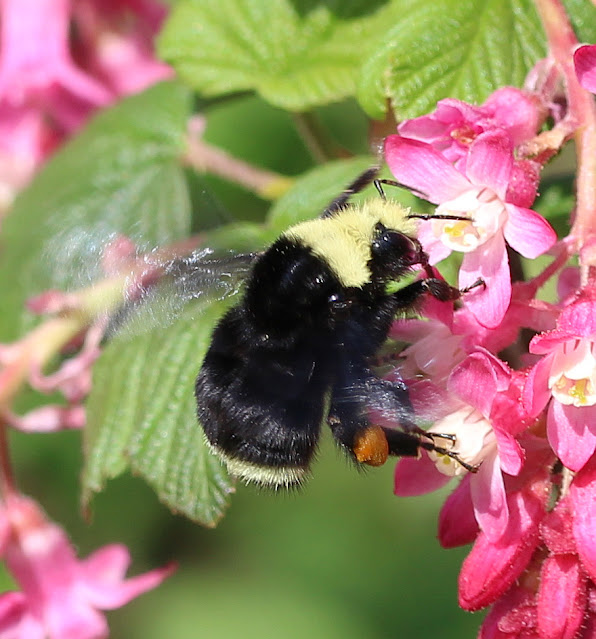It's officially spring and on warm sunny days in Vancouver the bumble bee queens are out and about foraging for nectar and looking for nesting sites. This is such an exciting time of the year for bee spotting!
We are still in pandemic mode, and with the fatigue and stress of so many months of lockdown, getting out and connecting with nature is more important than ever. I don't know about you, but my mood is very up and down these days. The vaccine is coming, but fatigue and fear is still a very real part of life. I have to keep reminding myself to get my daily dose of flower and bee watching. It does really help me keep calm and carry on doing the work I need to do, moving forward.
I like to try to get up early and get a good chunk of work done in the morning so I can spend one or two hours outside with the flowers and the bees. Seeing the first blossoms of spring emerge can be very thrilling. After a long, wet winter, it's such a relief to feel the sun on my face and find a spot where I can safely take off my masks and inhale the scent of the spring air with its delicate floral scents. It's especially glorious to find a re-flowering currant bush, sit on the ground and watch the bees and hummingbird foraging in its fragrant blossoms. The scent is resinous and seductive, reminding me of garden sage, but more delicate and floral. Taking time to enjoy the flowers without my camera in front of my face is a form of regenerative meditation.
My colleague Tyler calls the time spent outside with blossoms and bees the "flower hour". Love it! Renew your power in the Flower Hour! Inspired to connect with folks who love bees, we've created the NBSBC Bee Tracker project. We'd love you to join in the fun! And so we invite you to go out and spend your "flower hour" with the bees and the flowers and post your photos on iNaturalist with the tag "FlowerHour". If the bee you're seeing is a first bee, ie first bee of the year, first bumble bee, first mining bee, please feel free to use the tag "BCFirstBee". You can explain how it's a first bee in your notes. I've never used the journal on iNat, but I'm also determined to try out thus feature as well to add more detail to the field notes.
I'd like to personally invite you to a project on iNaturalist created by the Native Bee Society of British Columbia. We would love you join and post your photos of native B. C. bees! If you haven't joined iNaturalist, this would be a great time to start! You don't need a fancy iphone--you can just post sightings from your computer.
When you're posting photos of bees, it's important to try to crop them down so we can just focus on the details of the bee to try to identify it to Genus or species. In this photo you can see the whole side of the bee and the back leg, which is important to seeing if it is male or female. We also see the shape of the side of the head, the hairs on the "shoulders" of the bee and the side of the thorax and the entire abdomen.
It's also important for us to see all the parts of the bee, including the butt! The colour and length of the hairs and the shape of the very tip of the tail can give us clues to its ID.
In the case of this bumble bee, seeing the underside of the abdomen so we can check the sternites of the bee help us tell if tell two very similar species apart. Bombus calignosus has yellow hairs on the underside of its abdomen. In areas where there are B. calignosus this is particularly important to check. Don't be a perfectionist! Even blurry shots can help build the ID.
It also helps to see the face of the bee--the shape of the face, length of tongue, and the colour of the hairs on the front and top of the head. You can see why this is called the yellow-faced bumble bee!
It's also good to get a shot of the back of the bee so we can she the thorax, and the middle of the abdomen. This queen was the first I've seen of this year with a full pollen load. Exciting to know she's found a nest and starting to gather food for her first babies! So lovely to see a vigorous queen foraging in a native plant!
When I post a sighting on iNaturalist I like to make a note of what the bee is doing and which plant it is foraging on. If you want, you can make two posts with the same photos: one for the plant, and one for the bee.
I was also excited to see my first B. melanopygus of the year foraging in the sunwarmed blossoms. This is one of the earliest emerging species of our BC bumble bees, so there have been over 40 sightings of them reported on iNat in our province so far this year. Now that the yellow-faced bumble bees are waking up, the numbers of sighting have started to overtake the "mels". I'm having so much fun watching folks post their sightings of BC bees. Please join our project and consider becoming a member of The Native Bee Society of British Columbia to help us celebrate BC native bees!











Great blog post - I love the “flower hour”!!
ReplyDelete